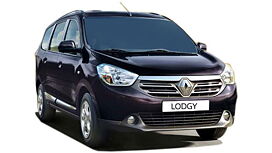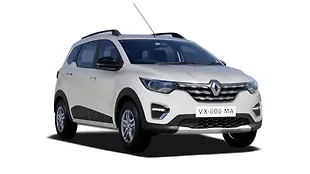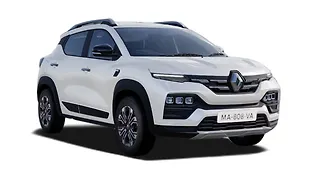Introduction

The Lodgy MUV is Renault’s attempt at making a mark in the premium seven-seater segment that is being ruled by the Toyota Innova for more than half a decade now. Where most of the Innova’s rivals failed for reasons like brand value, ownership cost, ‘taxi image’ and even looks, we try and find out if the Renault Lodgy stands a chance with the claimed modern underpinning, better performance and extra cabin space.
Looks
The MUVs are boxy out of necessity and maximising the cabin space is more important than styling. The good looks then come essentially from cosmetic upgrades and design elements that hide the bulk. The Lodgy at primary level is also a box, though Renault has made more than a few changes to try and make it more appealing.

Renault designs are generally a bit quirky and the Lodgy isn’t any different. The front gets a hexagonal grille with twin slat chrome inserts and the big Renault Logo in the middle. The bonnet has an unconventional design with subtle creases running parallel to the A pillar. The headlamp cluster is elongated like in most of the modern day cars with a conventional halogen set up occupying the bottom half while the parking light and side indicators take the top outside-half. The front bumper looks nice with the diffuser and chrome inserts for the round fog lamp units. The slightly flared wheel arches add bulk to the front and give the Lodgy a squat stance like that of the Duster.


Interior
The light coloured interior makes the already big cabin look even bigger. Unlike all the old-school MUVs including the Innova, the floor height of the Lodgy is much lower which allows you to step inside the cabin instead of making you climb in.
The two-tone dashboard layout is fresh and looks nice, though the equipment including the instrument cluster, AC vents with chrome inserts, touch-screen music system are same as that of the Duster AWD. Renault has also moved the ORVM adjustment switch from under the handbrake to the dashboard, which is a welcome change.

With a length of close to 4.5 metres, the Lodgy is almost as big as the Innova. It also has a larger wheelbase and bigger cabin, which then translates to more space. There is plenty of room in the second row though thigh support has been compromised; the all-important third row space is much better than its rivals including the Innova. There is space for two adults (both headroom and knee room), though with the high floor the passengers here will be sitting with raised knees and that may create problems for taller occupants especially on the long journeys.

Renault provides the option of selecting either a bench or two bucket seats for the middle row; both of them flip and tumble providing access to the back, but since these are mounted directly to the floor they do not slide. With all rows upright, this MUV offers 210 litres of boot space – which isn’t much, but still on par with the competition. Both the second and third row can be folded to increase boot space, in fact, the third row bench can be removed easily to create a delivery van-like-space.

The fit and finish of the Renault interior has been an issue and it is no different with the Lodgy. The steering wheel could have been much better and also the touch and feel of the dashboard components. It also uses the tacky steering column mounted audio controls, though the music quality is very nice. The features list is acceptable with the touch screen system (no CD player), cruise control, speed limiter, rear camera and sensors and independent AC vents for the second and third row of seats.

The main reason of buying a seven-seater MUV is the usable space it has to offer and the Lodgy definitely does a good job on this front. It can certainly fit seven people in comfort and that is a big plus especially since it manages to do that without looking like a box.

Performance
Like most other components, the Lodgy borrows its engine and transmission from the Duster. The Renault’s renowned K9K diesel engine does duty under the hood, powering the front wheels with either the 85bhp five-speed setup or the bigger 110bhp six-speed setup depending upon the variant.

We drove the top-end 110bhp RxZ variant that has a similar tuning to that of the FWD Duster. The first two gears are relatively short to improve the pulling capacity when fully loaded, while the fifth and sixth gears (especially sixth) are extremely tall for cruising on the highways. The 110bhp version of the Lodgy is capable of reaching 100kph in about 12 seconds and that is much quicker than all the MUVs in its segment. It also touches 100kph just under 2,000rpm in the sixth gear, delivering exceptional efficiency over long journeys. The official ARAI efficiency figures of this 110bhp version are 19.98kp while the 85bhp version is rated at 21.01kpl.

The turbo lag is prominent and despite the ample 245Nm of torque available starting 1,750rpm it feels sluggish till about 2,000rpm. This is where the turbo starts spooling and the car surges forward with great enthusiasm. The Lodgy is the most powerful MUV in the segment and though we tested the car only with two occupants, I am sure it will outperform the competition even with full load.
Renault has also improved the overall refinement and NVH of the car as compared to the Duster. There is diesel clatter outside, but feels completely muted inside the cabin. There isn’t much cabin noise till 110kph and it only starts becoming noisy post the 130kph mark.
Ride & Handling
The Lodgy rides exceptionally well even with just two occupants and it is bound to improve when the MUV is loaded further. It flattens bumps and potholes without any fuss; the ride quality is on par with the Duster if not better. I will not be exaggerating when I say that this is the best riding MUV in the segment by a great margin.

The monocoque chassis with FWD set up allows the Lodgy to be a decent handler, despite the high centre of gravity. There is body roll, but controlled, and zipping through slow moving traffic on the highway is not a problem. Of course, it won’t allow you to pull off any fancy manoeuvres. The steering feels nice and heavy although it does not provide much feedback.
The car rides on 185 / 65 R15 JK Vectra tyres, they look small but are good enough for the job. The brakes feel spongy at the start but offer extremely strong bite that is mainly to have enough stopping power with full load.
Verdict
The mechanical package of the Lodgy sets it apart from the competition. It has the best ride and handling balance, class leading performance figures and more than acceptable cabin space. The only problem is the quirky looks, though that should not be a big hurdle since Renault has already established itself as a premium brand.

The Lodgy will ideally compete with the Toyota Innova in terms of size, space and performance. Being a newer car, it does have an advantage over the Innova on most parameters, still it will be impossible to match the Japanese brand on after-sales service. Renault has a potential winner on its hand with the Lodgy and the most crucial point will be the pricing. If Renault manages to undercut the Innova by a substantial margin, the Lodgy will be the second success story for the French manufacturer, after the Duster.


























